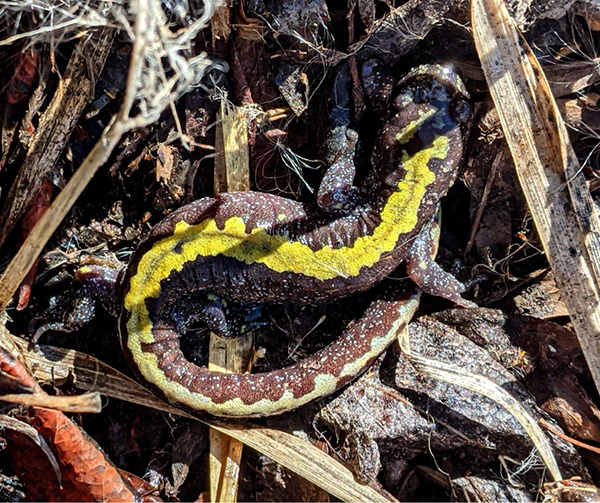BY LARRY BARNES
Salamanders are improbable creatures, especially in dry places with narrow windows of amphibian opportunity. But now there is a bit of moisture here in southern Idaho and our only local salamander is making its move. Long-toed salamanders are heading toward small bodies of water to mate and deposit their eggs. Theirs is a perilous journey that may involve road crossings, predators, and drying out through their delicate skin.
If they make it to a pond and find a mate, the females can produce well over 200 eggs. They are predators and must capture their wee prey items–insects and worms–to fuel the march through their habitat and their subsequent mating and egg laying. Avoiding predators is another chief concern, but their flashy yellow dorsal pattern suggests toxicity. If you are an easily digestible creature, the rule of thumb is that you will be well camouflaged. But our local salamanders are nowhere as toxic as their coastal kin, the rough-skinned newt, whose skin possesses a deadly neurotoxin. The long-toeds are innocuous creatures, however, with simple needs; they spend the majority of their 8 years or so at rest, hidden in darkness, immobile with their tiny brain and their tiny thoughts in places where they won’t freeze or dry out.
If those 200-plus eggs per female all survived and grew into adults, who in turn all produced eggs with similar generosity, and their progeny followed suit, Earth would be knee-deep in salamanders in just a few decades. Clearly, natural selection takes a large share. The eggs that do hatch and become larvae look like miniature adults except for their vertically flattened tails and external, feathery gills that serve them during their aquatic larvae-hood. Also, lacking yellow markings, the larvae are well-camouflaged and taste perfectly fine.
I know they are edible because in 1993 I visited 60 small lakes and bodies of water in the Sawtooth National Forest to conduct amphibian surveys. A theme became immediately clear: our three species of frogs and toads and one salamander do not thrive in the presence of super-predatory trout. Some frogs and toads marginally coexist in the same lakes with trout but only in those lakes having emergent shoreline vegetation where the tadpoles could hide and avoid becoming trout food. Salamanders were the most vulnerable and did not occur if trout were present. I only found six locations with salamander larvae. Introducing trout to formerly troutless lakes is a bad deal for native amphibians.
I asked my wife for advice on what to write about long-toed salamanders. She has a master’s degree in wildlife biology and years of experience in that field. She is a working, bonafide “biological scientist.” Her answer was immediate: “Talk about how cute they are!” and then lifted her arms from her sides, fingers dangling, adopting the look of salamander innocence floating motionless in clear water.
And that was the most enduring take-home message from the recent salamander encounter that inspired this column. We are surrounded by life forms, some common, others rare, all unique in how they answer life’s problems. Their phenotypes and genotypes dovetail with ours in myriad ways. Our eyes pass over the inanimate and stop at the symmetry of life, such as a small, cute salamander. The late E.O. Wilson recognized this love of life inherent in our species and gave it a word: biophilia. Now is the season when life’s happy hormones such as endorphins and oxytocin rain down on us whenever we go outside and connect with life on Earth.
Larry Barnes retired from 26 years as a biology teacher at Wood River High School and is now transitioning to spending more time exploring the natural world.



